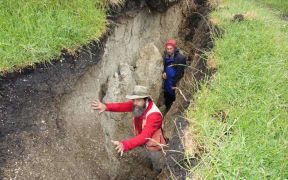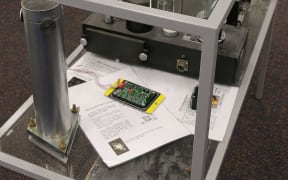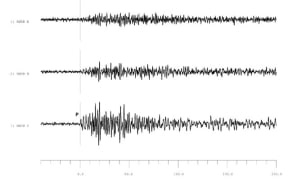A group of leading seismologists from New Zealand, Japan and Taiwan have been in Ōamaru this week to share the latest research.

Seismograph on display in the GeoNet briefing room. Photo: RNZ / Alison Ballance
The group of 70 scientists has been based in Ōamaru, but also spent time in Central Otago.
Otago University's chair of earthquake science, Professor Mark Stirling, said the meeting took place annually.
"We're all in countries where it's extremely important to understand where, and how big, the earthquake hazard is - so getting together each year gives us a chance to share and apply the latest scientific advances."
The focus of the meeting's discussion was on developing models and maps that show where earthquakes and strong shaking were most likely in each country, Mr Stirling said.
"As we know from recent events like Christchurch and Kaikōura, working out where the hazards are is not a simple task.
"Assessing hazard in what people are used to thinking of as 'low seismicity' areas will be one of the big topics of discussion.
"We will be sharing science and techniques for identifying active faults and understanding more about what might happen with faults that haven't done anything for a long time - like tens to hundreds of thousands of years."
It was one of the reasons why Ōamaru, which was considered a "low seismicity" area, was a great place for the meeting.
"There are fault lines around Ōamaru, like the Waihemo Fault running from Shag Point inland west to the top of the Pigroot, that haven't moved for a long time. What we want to understand is how these faults are likely to behave in future."
The seismic hazard models and maps developed by the scientists were used by engineers and planners to design buildings that could stand up to the shaking they were likely to experience, Mr Stirling said.
"These estimations of likely shaking produced by the science are used to set standards for buildings.
"For example in New Zealand, building standards depend in part on what and where you are building. Buildings like schools and hospitals will always be built to a higher standard than houses, and also to higher standards again in areas where there is a higher estimated earthquake hazard. Our highest standards are for large dams."
The scientists were also going to take the opportunity to visit the Kaikōura area, which experienced the most complex quake every recorded, and sites like the Clyde dam.
"The meeting participants are also really looking forward to the experience of staying in such a historic New Zealand town as Ōamaru."
The meeting was sponsored by EQC.





